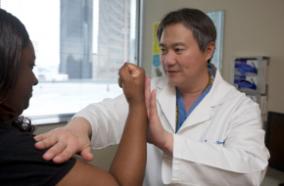4 years 9 months ago
CONCLUSIONS: Pleural effusion is a common complication of cardiac surgery and is associated with significant morbidity and resource utilization. This study identifies several associated complications that should be considered in the presence of pleural effusion. Modifiable associated factors in the management of drains that may contribute to accumulation of pleural effusion include: early removal of chest drains, higher outputs and removal during or close to mechanical ventilation. Further...
John D L Brookes
4 years 9 months ago
Cardiomyocytes undergo significant structural and functional changes after birth, and these fundamental processes are essential for the heart to pump blood to the growing body. However, due to the challenges of isolating single postnatal/adult myocytes, how individual newborn cardiomyocytes acquire multiple aspects of the mature phenotype remains poorly understood. Here we implement large-particle sorting and analyze single myocytes from neonatal to adult hearts. Early myocytes exhibit...
Sean A Murphy
4 years 9 months ago
Temozolomide (TMZ) is the standard of care chemotherapy drug for treating glioblastomas (GBMs), the most aggressive cancer that affects people of all ages. However, its therapeutic efficacy is limited by the drug resistance mediated by a DNA repair protein, O⁶-methylguanine-DNA methyltransferase (MGMT), which eliminates the TMZ-induced DNA lesions. Here we report the development of an iron oxide nanoparticle (NP) system for targeted delivery of siRNAs to suppress the TMZ-resistance gene (MGMT)....
Kui Wang
4 years 9 months ago
No abstract
Kouki Nakamura
4 years 9 months ago
Objectives: Chronic primary vasculitis describes a group of complex and rare diseases that are characterized by blood vessel inflammation. Classification of vasculitis subtypes is based predominantly on the size of the involved vessels and clinical phenotype. There is a recognized need to improve classification, especially for small-to-medium sized vessel vasculitides, that, ideally, is based on the underlying biology with a view to informing treatment. Methods: We performed RNA-Seq on blood...
Erin E Gill
4 years 9 months ago
CONCLUSION: RTP decisions following structural brain injury in athletes are markedly heterogeneous. While individualized RTP decisions are critical, aggregated expert opinions from 31 international sports neurosurgeons provide key insight. Level of play was found to be an important consideration in RTP determinations.
Scott L Zuckerman
4 years 9 months ago
Recurrent C11orf95-RELA fusions (RELA^(FUS)) are the hallmark of supratentorial ependymomas. The presence of RELA as the fusion partner indicates a close association of aberrant NF-κB activity with tumorigenesis. However, the oncogenic role of the C11orf95 has not been determined. Here, we performed ChIP-seq analyses to explore genomic regions bound by RELA^(FUS) and H3K27ac proteins in human 293T and mouse ependymoma cells. We then utilized published RNA-Seq data from human and mouse RELA^(FUS)...
Tatsuya Ozawa
4 years 9 months ago
CONCLUSIONS: This meta-analysis showed no significant difference in the rate of reported ocular injury between prone and supine critical care groups. These rates remain higher than the incidence reported during general anaesthesia. There is a need for studies in critical care settings in which ocular injury is an end-point and which include extended patient follow-up.
Timothy J Patterson
4 years 9 months ago
Portal vein aneurysms are rare pathologic entities. A 3.7-cm portal vein aneurysm was incidentally discovered in an 80-year-old male patient on imaging for acute abdominal pain secondary to an incarcerated diaphragmatic hernia. The aneurysm was resected, and primary repair of the portal vein was performed during a second-look operation after repair of the incarcerated hernia. Operative intervention was chosen for this patient because of the aneurysm's size and the additional indication for...
Tej A Sura
4 years 9 months ago
As frequency of endovascular treatments for intracranial aneurysms increases, there is a growing need to understand the mechanisms for coil embolization failure. Computational fluid dynamics (CFD) modeling often simplifies modeling the endovascular coils as a homogeneous porous medium, and focuses on the vascular wall endothelium, not considering the biomechanical environment of platelets. These assumptions limit the accuracy of computations for treatment predictions. We present a rigorous...
Venkat Keshav Chivukula
4 years 9 months ago
CONCLUSION: Presentation CTA findings combined with clinical factors may better predict the development of vasospasm in patients with aSAH compared to current prognostic models alone.
Charles G Colip
4 years 9 months ago
Autism spectrum disorder (ASD) manifests early in childhood. While genetic variants increase risk for ASD, a growing body of literature has established that in utero chemical exposures also contribute to ASD risk. These chemicals include air-based pollutants like diesel particulate matter (DPM). A combination of single-cell and direct transcriptomics of DPM-exposed human-induced pluripotent stem cell-derived cerebral organoids revealed toxicogenomic effects of DPM exposure during fetal brain...
Stephanie M Bilinovich
4 years 9 months ago
CONCLUSIONS: The QRS duration is increased in ICI myocarditis and is associated with increased MACE risk. Use of this widely available ECG parameter may aid in ICI myocarditis diagnosis and risk-stratification.
Daniel A Zlotoff
4 years 9 months ago
No abstract
Pedro Norat
4 years 9 months ago
CONCLUSIONS/INTERPRETATION: Our results demonstrate that diabetes mellitus induces a marked dysregulation of miRNAs associated with stem cell survival, proliferation and differentiation, and that therapeutic overexpression of prosurvival miR-30c-5p reduced diabetes-induced cell death and loss of MMP in CPCs via the newly identified target for miR-30c-5p, VDAC1.
Nima Purvis
4 years 9 months ago
BACKGROUND AND OBJECTIVES: Multiple sclerosis (MS) causes cognitive impairment in approximately 50% of cases. Disease modifying medications and cognitive rehabilitation produce only small positive effects on cognition in MS. Converging animal and human research suggests that aerobic exercise may improve cognition in people with MS, but definitive trials are lacking. We describe the design of the GET Smart study, a randomized controlled trial comparing the effects of aerobic exercise versus...
Charles H Bombardier
4 years 9 months ago
The ability to learn and remember verbal information is highly relevant to many work roles and environments, but we know little about the underlying cognitive mechanisms of those associations. This study examined the hypothesis that unemployment is associated with decreased spontaneous use of higher-order encoding strategies deployed during list learning and recall. Participants were 120 employed and 59 unemployed community-dwelling adults who completed the California Verbal Learning Test-Second...
Michael W Williams
4 years 9 months ago
No abstract
Sananthan Sivakanthan
4 years 9 months ago
Gliomas are the most common primary intrinsic brain tumors occurring in adults. Of all malignant gliomas, glioblastoma (GBM) is considered the deadliest tumor type due to diffuse brain invasion, immune evasion, cellular, and molecular heterogeneity, and resistance to treatments resulting in high rates of recurrence. An extensive understanding of the genomic and microenvironmental landscape of gliomas gathered over the past decade has renewed interest in pursuing novel therapeutics, including...
Pranjali P Kanvinde
4 years 9 months ago
CONCLUSION: Our findings support the inclusion of multiple exposure characteristics in the measurement of maltreatment and suggest that specific types of threat-specific maltreatment may have distinct associations with mental health sequelae.
Augustine Lombera
"university of washington"[affiliation] and neurological surge...: Latest results from PubMed
More posts about UW Neurological Surgery Recent PubMed Publications



















